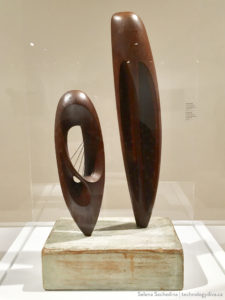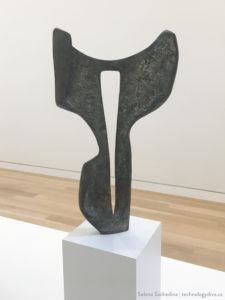In Search of Barbara Hepworth!
I have always loved art galleries. There is something to be said about standing in front of an actual Claude Monet painting and just being in awe because you are literally a foot away from something he touched, something he created. It’s like standing in front of history and being a part of it. I can see the strokes he used. I can see how he signed his name. It just brings me so much joy!
So when the opportunity came to volunteer at the Art Gallery of Ontario (AGO), I jumped at it. It was not only an opportunity to be constantly in the presence of these great works but also to witness gallery patrons be inspired by these artists too. As well, I saw it as an avenue to broaden my artistic pallet. I want to learn more about artists from all genres and eras. I want to learn why I like a certain piece of artwork and why I can’t stand others. I am excited to share what I learn here, on this blog.
On one of my first shifts at the AGO, a visitor asked me where he could find a work by Barbara Hepworth. To be honest, I never had heard of her before. What type of artist was she? What era did she work in? What made her so interesting? This man told me that it was one of the few pieces he had remembered at the AGO and very much wanted to see it again.
The AGO has fifteen Barbara Hepworth sculptures in their collection, three of which are on display at the moment.



So who was she? Barbara Hepworth (1903-1975) was a British artist known for her modern sculptures. She was a contemporary of British sculptor Henry Moore (which explains why one of her sculptures called ‘Figure (Oread)’ is featured beside the Henry Moore Sculpture Centre at the AGO). What makes her interesting is that she carved directly into her chosen materials (stone or wood for example) instead of the traditional way of the time which was creating models and having a craftsman carve the final piece. At the time, usually, this was something that only male sculptors would do. But why let them have all the fun? As you can see, she was very good. She liked to use natural materials because she wanted to connect more with nature. Her piece ‘Two Figures’, is made from redwood.
She liked to carve abstract pieces and this is what she is known for. But she did start out carving more recognizable or figurative sculptures first. As her career progressed and as she became more abstract in her work, she started to pierce her sculptures in order to open them up so that the viewer could be a part of the sculpture, which can be seen in all three AGO pieces. Working in bronze, allowed her to open up her sculptures even more. ‘Sea Form’ and ‘Figure (Oread)’ are done in bronze.
‘Two Figures’
This sculpture was a progression from her earlier works of a mother and child. In her earlier works, they were more recognizable figures of an actual mother and child. But as her career progressed, she became more abstract. So a lot of these types of works with two objects or more are situated in a way to indicate that they somehow have a relationship with each other. In this sculpture, she also used strings to accentuate the negative space. She did this a lot in her later years sometimes using paint and strings.
‘Sea Form (Porthmeor)’
Porthmeor is a beach close to Barbara Hepworth’s studio in St Ives, Cornwall. This piece is one of seven editions that can be found around the world. The Tate describes how the curves represent the movement of the water, sand and wind.
‘Figure (Oread)’
Again, this is one of seven editions of this sculpture that can be found around the world. An oread is a mountain nymph in Greek mythology. I had trouble figuring this out at first. The wall plaque at the AGO reads, “Tapered at the waist and fanned open at its shoulders, this torso appears to soar. It evokes the agile movements of an oread…” At first, I didn’t see what the sculpture was trying to convey but when I started reading about nymphs and how they are spirits who love to dance and sing, for me, it started to visually come together. It really convinced me that this woman was quite brilliant.
Final Thoughts…
I really love Barabara Hepworth’s abstract work the most, especially the sculptures that feature relationships such as ‘Two Figures’. I really love when she uses smooth forms because I find them very calming and relaxing to look at. I am so impressed with her ability to carve these smooth forms out herself. I really think it’s true when she said that piercing her work makes the viewer more involved. When I can see inside and through the materials, it does bring me closer to art pieces and therefore more involved with the work. It is an experience.
Additional Information:
The Tate: Who is Barbara Hepworth
barbarahepworth.org.uk
Google Images
Here is a great video that really gives a sense of what Barbara Hepworth was all about:

